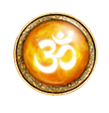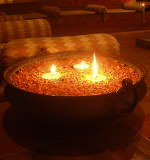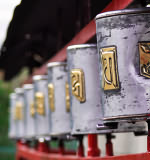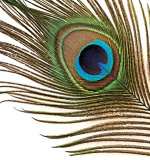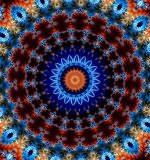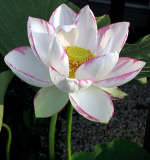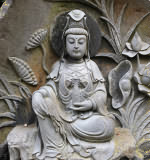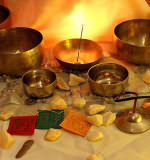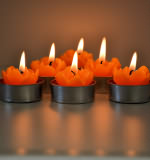| Töltsd le és telepítsd a nélkülözhetetlen betűtípusokat(s) Hogy megtekinthesd a Szanszkritot annak teljes fényében Olvass Transzliteráció (2) (magyar) hogy teljes mértékben átlásd a transzliterációs rendszert |
Tanulj Szanszkritul - Táblázatok
Táblázat, mely a Szanszkrit magánhangzók és mássalhangzók teljes kombinációját tartalmazza
Introduction
Hi, Gabriel Pradīpaka again. In this document I will not show you all possible combinations of "cons. + vowel, r + cons.", etc. (except when necessary). Not at all. I will show you all usual combinations of "cons. + vowel, r + cons.", etc. For example, this combination is possible: ya + ṛ = य + ऋ = यृ (yṛ), but though possible it is not usual. In fact, I have not seen that combination ever in practice. That is why you will see some blank cells in the tables every time that a combination is not usual even though possible. Another common example of this is ḷ vowel. It is possible to form many combinations of cons. + ḷ, but the only combination which is usually seen is kḷ (कॢ).
This document should be used as a complement to Writing document. The present tables are very important every time you want to verify if you are writing well in Sanskrit. In fact, some combinations such as "r + cons. + ṁ (Anusvāra)" are difficult to learn (e.g. r + ka + ṁ = र् + क +  = र्कं (rkaṁ), and the student generally needs a hand. For that reason, I have strived to show you in simple tables every usual combination of cons. + vowel, r + cons. and the like. Moreover, note that I follow the Sanskrit alphabetical order in the tables. Therefore, have the Alphabet at hand (print it if you can).
= र्कं (rkaṁ), and the student generally needs a hand. For that reason, I have strived to show you in simple tables every usual combination of cons. + vowel, r + cons. and the like. Moreover, note that I follow the Sanskrit alphabetical order in the tables. Therefore, have the Alphabet at hand (print it if you can).
Let us get down to work!
Cons. + a
As the Sanskrit alphabet is syllabic and each of the consonants already includes "a", this table coincides with the Sanskrit alphabet you may find in Alphabet (English) as far as consonants is concerned, except "ṅa" and "ña" which are not usually seen.
| Gutturals | क | ka | ख | kha | ग | ga | घ | gha | - | - |
| Palatals | च | ca | छ | cha | ज | ja | झ | jha | - | - |
| Cerebrals | ट | ṭa | ठ | ṭha | ड | ḍa | ढ | ḍha | ण | ṇa |
| Dentals | त | ta | थ | tha | द | da | ध | dha | न | na |
| Labials | प | pa | फ | pha | ब | ba | भ | bha | म | ma |
| Semivowels | य | ya | र | ra | ल | la | व | va | Cells with hyphen indicate combinations which are not usually seen. | |
| Sibilants and Sonant Aspirate | श | śa | ष | ṣa | स | sa | ह | ha | ||
Cons. + ā
The vowel "ā" after consonant is represented by the following character:  . This stick-like character must be placed "after" the consonant.
. This stick-like character must be placed "after" the consonant.
| Gutturals | का | kā | खा | khā | गा | gā | घा | ghā | - | - |
| Palatals | चा | cā | छा | chā | जा | jā | झा | jhā | - | - |
| Cerebrals | टा | ṭā | ठा | ṭhā | डा | ḍā | ढा | ḍhā | णा | ṇā |
| Dentals | ता | tā | था | thā | दा | dā | धा | dhā | ना | nā |
| Labials | पा | pā | फा | phā | बा | bā | भा | bhā | मा | mā |
| Semivowels | या | yā | रा | rā | ला | lā | वा | vā | Cells with hyphen indicate combinations which are not usually seen. | |
| Sibilants and Sonant Aspirate | शा | śā | षा | ṣā | सा | sā | हा | hā | ||
Cons. + i
The vowel "i" after consonant is represented by the following character:  . This character must be placed "before" the consonant.
. This character must be placed "before" the consonant.
| Gutturals | कि | ki | खि | khi | गि | gi | घि | ghi | - | - |
| Palatals | चि | ci | छि | chi | जि | ji | झि | jhi | - | - |
| Cerebrals | टि | ṭi | ठि | ṭhi | डि | ḍi | ढि | ḍhi | णि | ṇi |
| Dentals | ति | ti | थि | thi | दि | di | धि | dhi | नि | ni |
| Labials | पि | pi | फि | phi | बि | bi | भि | bhi | मि | mi |
| Semivowels | यि | yi | रि | ri | लि | li | वि | vi | Cells with hyphen indicate combinations which are not usually seen. | |
| Sibilants and Sonant Aspirate | शि | śi | षि | ṣi | सि | si | हि | hi | ||
Cons. + ī
The vowel "ī" after consonant is represented by the following character:  . This character must be placed "after" the consonant.
. This character must be placed "after" the consonant.
| Gutturals | की | kī | खी | khī | गी | gī | घी | ghī | - | - |
| Palatals | ची | cī | छी | chī | जी | jī | झी | jhī | - | - |
| Cerebrals | टी | ṭī | ठी | ṭhī | डी | ḍī | ढी | ḍhī | णी | ṇī |
| Dentals | ती | tī | थी | thī | दी | dī | धी | dhī | नी | nī |
| Labials | पी | pī | फी | phī | बी | bī | भी | bhī | मी | mī |
| Semivowels | यी | yī | री | rī | ली | lī | वी | vī | Cells with hyphen indicate combinations which are not usually seen. | |
| Sibilants and Sonant Aspirate | शी | śī | षी | ṣī | सी | sī | ही | hī | ||
Cons. + u
The vowel "u" after consonant is represented by the following character:  . This character must be placed "under" the consonant, except "ra" (See "ru"). Besides, the character must be drawn in contact with the vertical line in those consonants having one, of course.
. This character must be placed "under" the consonant, except "ra" (See "ru"). Besides, the character must be drawn in contact with the vertical line in those consonants having one, of course.
| Gutturals | कु | ku | खु | khu | गु | gu | घु | ghu | - | - |
| Palatals | चु | cu | छु | chu | जु | ju | झु | jhu | - | - |
| Cerebrals | टु | ṭu | ठु | ṭhu | डु | ḍu | ढु | ḍhu | णु | ṇu |
| Dentals | तु | tu | थु | thu | दु | du | धु | dhu | नु | nu |
| Labials | पु | pu | फु | phu | बु | bu | भु | bhu | मु | mu |
| Semivowels | यु | yu | रु | ru | लु | lu | वु | vu | Cells with hyphen indicate combinations which are not usually seen. | |
| Sibilants and Sonant Aspirate | शु | śu | षु | ṣu | सु | su | हु | hu | ||
Cons. + ū
The vowel "ū" after consonant is represented by the following character:  . This character must be placed "under" the consonant, except "ra" (See "rū"). Besides, the character must be drawn in contact with the vertical line in those consonants having one, of course.
. This character must be placed "under" the consonant, except "ra" (See "rū"). Besides, the character must be drawn in contact with the vertical line in those consonants having one, of course.
| Gutturals | कू | kū | खू | khū | गू | gū | घू | ghū | - | - |
| Palatals | चू | cū | छू | chū | जू | jū | झू | jhū | - | - |
| Cerebrals | टू | ṭū | ठू | ṭhū | डू | ḍū | ढू | ḍhū | णू | ṇū |
| Dentals | तू | tū | थू | thū | दू | dū | धू | dhū | नू | nū |
| Labials | पू | pū | फू | phū | बू | bū | भू | bhū | मू | mū |
| Semivowels | यू | yū | रू | rū | लू | lū | वू | vū | Cells with hyphen indicate combinations which are not usually seen. | |
| Sibilants and Sonant Aspirate | शू | śū | षू | ṣū | सू | sū | हू | hū | ||
Cons. + ṛ
The vowel "ṛ" after consonant is represented by the following character:  . This character must be placed "under" the consonant. Besides, the character must be drawn in contact with the vertical line in those consonants having one, of course. Also note that da + ṛ = dṛ and ha + ṛ = hṛ form conjuncts (See Conjuncts). A last thing,
. This character must be placed "under" the consonant. Besides, the character must be drawn in contact with the vertical line in those consonants having one, of course. Also note that da + ṛ = dṛ and ha + ṛ = hṛ form conjuncts (See Conjuncts). A last thing,
l + ṛ = lṛ and not "ḷ" (the vowel). In other words, lṛ (l + ṛ) is लृ while ḷ (the vowel) is ऌ, careful!
| Gutturals | कृ | kṛ | खृ | khṛ | गृ | gṛ | घृ | ghṛ | - | - |
| Palatals | चृ | cṛ | छृ | chṛ | जृ | jṛ | - | - | - | - |
| Cerebrals | - | - | - | - | - | - | - | - | - | - |
| Dentals | तृ | tṛ | - | - | दृ | dṛ | धृ | dhṛ | नृ | nṛ |
| Labials | पृ | pṛ | - | - | बृ | bṛ | भृ | bhṛ | मृ | mṛ |
| Semivowels | - | - | - | - | लृ | lṛ | वृ | vṛ | Cells with hyphen indicate combinations which are not usually seen. | |
| Sibilants and Sonant Aspirate | शृ | śṛ | - | - | सृ | sṛ | हृ | hṛ | ||
Cons. + ṝ
The vowel "ṝ" after consonant is represented by the following character:  . This character must be placed "under" the consonant. Besides, the character must be drawn in contact with the vertical line in those consonants having one, of course.
. This character must be placed "under" the consonant. Besides, the character must be drawn in contact with the vertical line in those consonants having one, of course.
| Gutturals | कॄ | kṝ | - | - | गॄ | gṝ | - | - | - | - |
| Palatals | - | - | - | - | जॄ | jṝ | - | - | - | - |
| Cerebrals | - | - | - | - | - | - | - | - | - | - |
| Dentals | तॄ | tṝ | - | - | दॄ | dṝ | धॄ | dhṝ | नॄ | nṝ |
| Labials | पॄ | pṝ | - | - | बॄ | bṝ | भॄ | bhṝ | मॄ | mṝ |
| Semivowels | - | - | - | - | - | - | वॄ | vṝ | Cells with hyphen indicate combinations which are not usually seen. | |
| Sibilants and Sonant Aspirate | शॄ | śṝ | - | - | सॄ | sṝ | - | - | ||
Cons. + ḷ
The vowel "ḷ" after consonant is represented by the following character: . This character must be placed "under" the consonant. Besides, the character must be drawn in contact with the vertical line of "k" (the only letter presenting usual combinations with ḷ).
. This character must be placed "under" the consonant. Besides, the character must be drawn in contact with the vertical line of "k" (the only letter presenting usual combinations with ḷ).
| Gutturals | कॢ | kḷ | - | - | - | - | - | - | - | - |
| Palatals | - | - | - | - | - | - | - | - | - | - |
| Cerebrals | - | - | - | - | - | - | - | - | - | - |
| Dentals | - | - | - | - | - | - | - | - | - | - |
| Labials | - | - | - | - | - | - | - | - | - | - |
| Semivowels | - | - | - | - | - | - | - | - | Cells with hyphen indicate combinations which are not usually seen. | |
| Sibilants and Sonant Aspirate | - | - | - | - | - | - | - | - | ||
Cons. + e
The vowel "e" after consonant is represented by the following character:  . This character must be placed "above" the consonant. Besides, the character must be drawn in contact with the vertical line (short or long).
. This character must be placed "above" the consonant. Besides, the character must be drawn in contact with the vertical line (short or long).
| Gutturals | के | ke | खे | khe | गे | ge | घे | ghe | - | - |
| Palatals | चे | ce | छे | che | जे | je | झे | jhe | - | - |
| Cerebrals | टे | ṭe | ठे | ṭhe | डे | ḍe | ढे | ḍhe | णे | ṇe |
| Dentals | ते | te | थे | the | दे | de | धे | dhe | ने | ne |
| Labials | पे | pe | फे | phe | बे | be | भे | bhe | मे | me |
| Semivowels | ये | ye | रे | re | ले | le | वे | ve | Cells with hyphen indicate combinations which are not usually seen. | |
| Sibilants and Sonant Aspirate | शे | śe | षे | ṣe | से | se | हे | he | ||
Cons. + ai
The vowel "ai" after consonant is represented by the following character:  . This character must be placed "above" the consonant. Besides, the character must be drawn in contact with the vertical line (short or long).
. This character must be placed "above" the consonant. Besides, the character must be drawn in contact with the vertical line (short or long).
| Gutturals | कै | kai | खै | khai | गै | gai | घै | ghai | - | - |
| Palatals | चै | cai | छै | chai | जै | jai | झै | jhai | - | - |
| Cerebrals | टै | ṭai | ठै | ṭhai | डै | ḍai | ढै | ḍhai | णै | ṇai |
| Dentals | तै | tai | थै | thai | दै | dai | धै | dhai | नै | nai |
| Labials | पै | pai | फै | phai | बै | bai | भै | bhai | मै | mai |
| Semivowels | यै | yai | रै | rai | लै | lai | वै | vai | Cells with hyphen indicate combinations which are not usually seen. | |
| Sibilants and Sonant Aspirate | शै | śai | षै | ṣai | सै | sai | है | hai | ||
Cons. + o
The vowel "o" after consonant is represented by the following character:  . This character must be placed "after" the consonant.
. This character must be placed "after" the consonant.
| Gutturals | को | ko | खो | kho | गो | go | घो | gho | - | - |
| Palatals | चो | co | छो | cho | जो | jo | झो | jho | - | - |
| Cerebrals | टो | ṭo | ठो | ṭho | डो | ḍo | ढो | ḍho | णो | ṇo |
| Dentals | तो | to | थो | tho | दो | do | धो | dho | नो | no |
| Labials | पो | po | फो | pho | बो | bo | भो | bho | मो | mo |
| Semivowels | यो | yo | रो | ro | लो | lo | वो | vo | Cells with hyphen indicate combinations which are not usually seen. | |
| Sibilants and Sonant Aspirate | शो | śo | षो | ṣo | सो | so | हो | ho | ||
Cons. + au
The vowel "au" after consonant is represented by the following character:  . This character must be placed "after" the consonant.
. This character must be placed "after" the consonant.
| Gutturals | कौ | kau | खौ | khau | गौ | gau | घौ | ghau | - | - |
| Palatals | चौ | cau | छौ | chau | जौ | jau | झौ | jhau | - | - |
| Cerebrals | टौ | ṭau | ठौ | ṭhau | डौ | ḍau | ढौ | ḍhau | णौ | ṇau |
| Dentals | तौ | tau | थौ | thau | दौ | dau | धौ | dhau | नौ | nau |
| Labials | पौ | pau | फौ | phau | बौ | bau | भौ | bhau | मौ | mau |
| Semivowels | यौ | yau | रौ | rau | लौ | lau | वौ | vau | Cells with hyphen indicate combinations which are not usually seen. | |
| Sibilants and Sonant Aspirate | शौ | śau | षौ | ṣau | सौ | sau | हौ | hau | ||
Cons. + ṁ
The vowel "ṁ" (Anusvāra) after consonant is represented by the following character:  (one dot). This character must be placed "above" the consonant. Besides, the character must be drawn "right" above the vertical line (short or long).
(one dot). This character must be placed "above" the consonant. Besides, the character must be drawn "right" above the vertical line (short or long).
| Gutturals | कं | kaṁ | खं | khaṁ | गं | gaṁ | घं | ghaṁ | - | - |
| Palatals | चं | caṁ | छं | chaṁ | जं | jaṁ | झं | jhaṁ | - | - |
| Cerebrals | टं | ṭaṁ | ठं | ṭhaṁ | डं | ḍaṁ | ढं | ḍhaṁ | णं | ṇaṁ |
| Dentals | तं | taṁ | थं | thaṁ | दं | daṁ | धं | dhaṁ | नं | naṁ |
| Labials | पं | paṁ | फं | phaṁ | बं | baṁ | भं | bhaṁ | मं | maṁ |
| Semivowels | यं | yaṁ | रं | raṁ | लं | laṁ | वं | vaṁ | Cells with hyphen indicate combinations which are not usually seen. | |
| Sibilants and Sonant Aspirate | शं | śaṁ | षं | ṣaṁ | सं | saṁ | हं | haṁ | ||
Cons. + ḥ
The vowel "ḥ" (Visarga) after consonant is represented by the following character: : (two dots). This character must be placed "after" the consonant.
| Gutturals | कः | kaḥ | खः | khaḥ | गः | gaḥ | घः | ghaḥ | - | - |
| Palatals | चः | caḥ | छः | chaḥ | जः | jaḥ | झः | jhaḥ | - | - |
| Cerebrals | टः | ṭaḥ | ठः | ṭhaḥ | डः | ḍaḥ | ढः | ḍhaḥ | णः | ṇaḥ |
| Dentals | तः | taḥ | थः | thaḥ | दः | daḥ | धः | dhaḥ | नः | naḥ |
| Labials | पः | paḥ | फः | phaḥ | बः | baḥ | भः | bhaḥ | मः | maḥ |
| Semivowels | यः | yaḥ | रः | raḥ | लः | laḥ | वः | vaḥ | Cells with hyphen indicate combinations which are not usually seen. | |
| Sibilants and Sonant Aspirate | शः | śaḥ | षः | ṣaḥ | सः | saḥ | हः | haḥ | ||
Cons. + i + ṁ (ANUSVĀRA)
In this case, you must draw "i" as usual (i.e. before the consonant) and place Anusvāra right above the vertical line (short or long).
| Gutturals | किं | kiṁ | खिं | khiṁ | गिं | giṁ | घिं | ghiṁ | - | - |
| Palatals | चिं | ciṁ | छिं | chiṁ | जिं | jiṁ | झिं | jhiṁ | - | - |
| Cerebrals | टिं | ṭiṁ | ठिं | ṭhiṁ | डिं | ḍiṁ | ढिं | ḍhiṁ | णिं | ṇiṁ |
| Dentals | तिं | tiṁ | थिं | thiṁ | दिं | diṁ | धिं | dhiṁ | निं | niṁ |
| Labials | पिं | piṁ | फिं | phiṁ | बिं | biṁ | भिं | bhiṁ | मिं | miṁ |
| Semivowels | यिं | yiṁ | रिं | riṁ | लिं | liṁ | विं | viṁ | Cells with hyphen indicate combinations which are not usually seen. | |
| Sibilants and Sonant Aspirate | शिं | śiṁ | षिं | ṣiṁ | सिं | siṁ | हिं | hiṁ | ||
Cons. + ī + ṁ (ANUSVĀRA)
In this case, you must draw "ī" as usual (i.e. after the consonant) and place Anusvāra on the right. Look:
| Gutturals | कीं | kīṁ | खीं | khīṁ | गीं | gīṁ | घीं | ghīṁ | - | - |
| Palatals | चीं | cīṁ | छीं | chīṁ | जीं | jīṁ | झीं | jhīṁ | - | - |
| Cerebrals | टीं | ṭīṁ | ठीं | ṭhīṁ | डीं | ḍīṁ | ढीं | ḍhīṁ | णीं | ṇīṁ |
| Dentals | तीं | tīṁ | थीं | thīṁ | दीं | dīṁ | धीं | dhīṁ | नीं | nīṁ |
| Labials | पीं | pīṁ | फीं | phīṁ | बीं | bīṁ | भीं | bhīṁ | मीं | mīṁ |
| Semivowels | यीं | yīṁ | रीं | rīṁ | लीं | līṁ | वीं | vīṁ | Cells with hyphen indicate combinations which are not usually seen. | |
| Sibilants and Sonant Aspirate | शीं | śīṁ | षीं | ṣīṁ | सीं | sīṁ | हीं | hīṁ | ||
Cons. + e + ṁ (ANUSVĀRA)
In this case, you must draw "e" as usual (i.e. above the consonant) and place Anusvāra on the right. Note that there is no word beginning or ending with these combinations, but some of them might "maybe" appear within a word. I have not investigated if this is true yet.
| Gutturals | कें | keṁ | खें | kheṁ | गें | geṁ | घें | gheṁ | - | - |
| Palatals | चें | ceṁ | छें | cheṁ | जें | jeṁ | झें | jheṁ | - | - |
| Cerebrals | टें | ṭeṁ | ठें | ṭheṁ | डें | ḍeṁ | ढें | ḍheṁ | णें | ṇeṁ |
| Dentals | तें | teṁ | थें | theṁ | दें | deṁ | धें | dheṁ | नें | neṁ |
| Labials | पें | peṁ | फें | pheṁ | बें | beṁ | भें | bheṁ | में | meṁ |
| Semivowels | यें | yeṁ | रें | reṁ | लें | leṁ | वें | veṁ | In this case, no words either begin or end with these combinations, but some of them "might" appear within a word anyway. That is why I kept all of them. | |
| Sibilants and Sonant Aspirate | शें | śeṁ | षें | ṣeṁ | सें | seṁ | हें | heṁ | ||
Cons. + ai + ṁ (ANUSVĀRA)
Just as with "e", you must draw "ai" as usual (i.e. above the consonant) and place Anusvāra on the right. Note that some of the following combinations might not be usual... I have not strictly found out which ones are usual yet, but I know that "kaiṁ", "vaiṁ", "saiṁ" and "haiṁ" actually appear in some words.
| Gutturals | कैं | kaiṁ | खैं | khaiṁ | गैं | gaiṁ | घैं | ghaiṁ | - | - |
| Palatals | चैं | caiṁ | छैं | chaiṁ | जैं | jaiṁ | झैं | jhaiṁ | - | - |
| Cerebrals | टैं | ṭaiṁ | ठैं | ṭhaiṁ | डैं | ḍaiṁ | ढैं | ḍhaiṁ | णैं | ṇaiṁ |
| Dentals | तैं | taiṁ | थैं | thaiṁ | दैं | daiṁ | धैं | dhaiṁ | नैं | naiṁ |
| Labials | पैं | paiṁ | फैं | phaiṁ | बैं | baiṁ | भैं | bhaiṁ | मैं | maiṁ |
| Semivowels | यैं | yaiṁ | रैं | raiṁ | लैं | laiṁ | वैं | vaiṁ | In this case, some of the following combinations might not be usual... I have not strictly found out which ones are usual yet, but I know that "kaiṁ", "vaiṁ", "saiṁ" and "haiṁ" actually appear in some words. Just in case, I kept all of them anyway. | |
| Sibilants and Sonant Aspirate | शैं | śaiṁ | षैं | ṣaiṁ | सैं | saiṁ | हैं | haiṁ | ||
Cons. + o + ṁ (ANUSVĀRA)
You must draw "o" as usual (i.e. after the consonant) and place Anusvāra on the right. Note that some of the following combinations might not be usual... I have not strictly found out which ones are usual yet, but I know that "koṁ", "bhoṁ" and "śoṁ" actually appear in some words.
| Gutturals | कों | koṁ | खों | khoṁ | गों | goṁ | घों | ghoṁ | - | - |
| Palatals | चों | coṁ | छों | choṁ | जों | joṁ | झों | jhoṁ | - | - |
| Cerebrals | टों | ṭoṁ | ठों | ṭhoṁ | डों | ḍoṁ | ढों | ḍhoṁ | णों | ṇoṁ |
| Dentals | तों | toṁ | थों | thoṁ | दों | doṁ | धों | dhoṁ | नों | noṁ |
| Labials | पों | poṁ | फों | phoṁ | बों | boṁ | भों | bhoṁ | मों | moṁ |
| Semivowels | यों | yoṁ | रों | roṁ | लों | loṁ | वों | voṁ | In this case, some of the following combinations might not be usual... I have not strictly found out which ones are usual yet, but I know that "koṁ", "bhoṁ", and "śoṁ" actually appear in some words. Just in case, I kept all of them anyway. | |
| Sibilants and Sonant Aspirate | शों | śoṁ | षों | ṣoṁ | सों | soṁ | हों | hoṁ | ||
Cons. + au + ṁ (ANUSVĀRA)
Just as with "o", you must draw "au" as usual (i.e. after the consonant) and place Anusvāra on the right. Note that some of the following combinations might not be usual... I have not strictly found out which ones are usual yet, but I know that "pauṁ" actually appears in some words.
| Gutturals | कौं | kauṁ | खौं | khauṁ | गौं | gauṁ | घौं | ghauṁ | - | - |
| Palatals | चौं | cauṁ | छौं | chauṁ | जौं | jauṁ | झौं | jhauṁ | - | - |
| Cerebrals | टौं | ṭauṁ | ठौं | ṭhauṁ | डौं | ḍauṁ | ढौं | ḍhauṁ | णौं | ṇauṁ |
| Dentals | तौं | tauṁ | थौं | thauṁ | दौं | dauṁ | धौं | dhauṁ | नौं | nauṁ |
| Labials | पौं | pauṁ | फौं | phauṁ | बौं | bauṁ | भौं | bhauṁ | मौं | mauṁ |
| Semivowels | यौं | yauṁ | रौं | rauṁ | लौं | lauṁ | वौं | vauṁ | In this case, some of the following combinations might not be usual... I have not strictly found out which ones are usual yet, but I know that "pauṁ" actually appears in some words. Just in case, I kept all of them anyway. | |
| Sibilants and Sonant Aspirate | शौं | śauṁ | षौं | ṣauṁ | सौं | sauṁ | हौं | hauṁ | ||
r + cons.
A piece of cake! Just place the hook-like character ( ) representing "r" before consonant on top of the consonant itself.
) representing "r" before consonant on top of the consonant itself.
| Gutturals | र्क | rka | र्ख | rkha | र्ग | rga | र्घ | rgha | - | - |
| Palatals | र्च | rca | र्छ | rcha | र्ज | rja | र्झ | rjha | - | - |
| Cerebrals | र्ट | rṭa | र्ठ | rṭha | र्ड | rḍa | र्ढ | rḍha | र्ण | rṇa |
| Dentals | र्त | rta | र्थ | rtha | र्द | rda | र्ध | rdha | र्न | rna |
| Labials | र्प | rpa | र्फ | rpha | र्ब | rba | र्भ | rbha | र्म | rma |
| Semivowels | र्य | rya | - | - | र्ल | rla | र्व | rva | Cells with hyphen indicate combinations which are not usually seen. | |
| Sibilants and Sonant Aspirate | र्श | rśa | र्ष | rṣa | र्स | rsa | र्ह | rha | ||
r + cons. + ā
In this case, the hook-like character ( ) must be placed on top of the "ā" vowel (
) must be placed on top of the "ā" vowel ( ) and not on top of the consonant.
) and not on top of the consonant.
| Gutturals | र्का | rkā | र्खा | rkhā | र्गा | rgā | र्घा | rghā | - | - |
| Palatals | र्चा | rcā | र्छा | rchā | र्जा | rjā | र्झा | rjhā | - | - |
| Cerebrals | र्टा | rṭā | र्ठा | rṭhā | र्डा | rḍā | र्ढा | rḍhā | र्णा | rṇā |
| Dentals | र्ता | rtā | र्था | rthā | र्दा | rdā | र्धा | rdhā | र्ना | rnā |
| Labials | र्पा | rpā | र्फा | rphā | र्बा | rbā | र्भा | rbhā | र्मा | rmā |
| Semivowels | र्या | ryā | - | - | र्ला | rlā | र्वा | rvā | Cells with hyphen indicate combinations which are not usually seen. | |
| Sibilants and Sonant Aspirate | र्शा | rśā | र्षा | rṣā | र्सा | rsā | र्हा | rhā | ||
r + cons. + i
In this case, the hook-like character ( ) must be placed on top of the consonant.
) must be placed on top of the consonant.
| Gutturals | र्कि | rki | र्खि | rkhi | र्गि | rgi | र्घि | rghi | - | - |
| Palatals | र्चि | rci | र्छि | rchi | र्जि | rji | र्झि | rjhi | - | - |
| Cerebrals | र्टि | rṭi | र्ठि | rṭhi | र्डि | rḍi | र्ढि | rḍhi | र्णि | rṇi |
| Dentals | र्ति | rti | र्थि | rthi | र्दि | rdi | र्धि | rdhi | र्नि | rni |
| Labials | र्पि | rpi | र्फि | rphi | र्बि | rbi | र्भि | rbhi | र्मि | rmi |
| Semivowels | र्यि | ryi | - | - | र्लि | rli | र्वि | rvi | Cells with hyphen indicate combinations which are not usually seen. | |
| Sibilants and Sonant Aspirate | र्शि | rśi | र्षि | rṣi | र्सि | rsi | र्हि | rhi | ||
r + cons. + ī
In this case, the hook-like character ( ) must be placed to the right of "ī" vowel (
) must be placed to the right of "ī" vowel ( ). In fact, the "r" character is practically merged into the curved portion of "ī" character. Look:
). In fact, the "r" character is practically merged into the curved portion of "ī" character. Look:
| Gutturals | र्की | rkī | र्खी | rkhī | र्गी | rgī | र्घी | rghī | - | - |
| Palatals | र्ची | rcī | र्छी | rchī | र्जी | rjī | र्झी | rjhī | - | - |
| Cerebrals | र्टी | rṭī | र्ठी | rṭhī | र्डी | rḍī | र्ढी | rḍhī | र्णी | rṇī |
| Dentals | र्ती | rtī | र्थी | rthī | र्दी | rdī | र्धी | rdhī | र्नी | rnī |
| Labials | र्पी | rpī | र्फी | rphī | र्बी | rbī | र्भी | rbhī | र्मी | rmī |
| Semivowels | र्यी | ryī | - | - | र्ली | rlī | र्वी | rvī | Cells with hyphen indicate combinations which are not usually seen. | |
| Sibilants and Sonant Aspirate | र्शी | rśī | र्षी | rṣī | र्सी | rsī | र्ही | rhī | ||
r + cons. + u
In this case, the hook-like character ( ) must be placed on top of the consonant as usual. Nothing strange happening here, hehe.
) must be placed on top of the consonant as usual. Nothing strange happening here, hehe.
| Gutturals | र्कु | rku | र्खु | rkhu | र्गु | rgu | र्घु | rghu | - | - |
| Palatals | र्चु | rcu | र्छु | rchu | र्जु | rju | र्झु | rjhu | - | - |
| Cerebrals | र्टु | rṭu | र्ठु | rṭhu | र्डु | rḍu | र्ढु | rḍhu | र्णु | rṇu |
| Dentals | र्तु | rtu | र्थु | rthu | र्दु | rdu | र्धु | rdhu | र्नु | rnu |
| Labials | र्पु | rpu | र्फु | rphu | र्बु | rbu | र्भु | rbhu | र्मु | rmu |
| Semivowels | र्यु | ryu | - | - | र्लु | rlu | र्वु | rvu | Cells with hyphen indicate combinations which are not usually seen. | |
| Sibilants and Sonant Aspirate | र्शु | rśu | र्षु | rṣu | र्सु | rsu | र्हु | rhu | ||
r + cons. + ū
Just as with "u", the hook-like character ( ) must be placed on top of the consonant as usual.
) must be placed on top of the consonant as usual.
| Gutturals | र्कू | rkū | र्खू | rkhū | र्गू | rgū | र्घू | rghū | - | - |
| Palatals | र्चू | rcū | र्छू | rchū | र्जू | rjū | र्झू | rjhū | - | - |
| Cerebrals | र्टू | rṭū | र्ठू | rṭhū | र्डू | rḍū | र्ढू | rḍhū | र्णू | rṇū |
| Dentals | र्तू | rtū | र्थू | rthū | र्दू | rdū | र्धू | rdhū | र्नू | rnū |
| Labials | र्पू | rpū | र्फू | rphū | र्बू | rbū | र्भू | rbhū | र्मू | rmū |
| Semivowels | र्यू | ryū | - | - | र्लू | rlū | र्वू | rvū | Cells with hyphen indicate combinations which are not usually seen. | |
| Sibilants and Sonant Aspirate | र्शू | rśū | र्षू | rṣū | र्सू | rsū | र्हू | rhū | ||
r + cons. + ṛ
Just as with "ū", the hook-like character ( ) must be placed on top of the consonant as usual.
) must be placed on top of the consonant as usual.
| Gutturals | र्कृ | rkṛ | र्खृ | rkhṛ | र्गृ | rgṛ | र्घृ | rghṛ | - | - |
| Palatals | र्चृ | rcṛ | र्छृ | rchṛ | र्जृ | rjṛ | - | - | - | - |
| Cerebrals | - | - | - | - | - | - | - | - | - | - |
| Dentals | र्तृ | rtṛ | - | - | र्दृ | rdṛ | र्धृ | rdhṛ | र्नृ | rnṛ |
| Labials | र्पृ | rpṛ | - | - | र्बृ | rbṛ | र्भृ | rbhṛ | र्मृ | rmṛ |
| Semivowels | - | - | - | - | र्लृ | rlṛ | र्वृ | rvṛ | Cells with hyphen indicate combinations which are not usually seen. | |
| Sibilants and Sonant Aspirate | र्शृ | rśṛ | - | - | र्सृ | rsṛ | र्हृ | rhṛ | ||
r + cons. + ṝ
Just as with "ṛ", the hook-like character ( ) must be placed on top of the consonant as usual.
) must be placed on top of the consonant as usual.
| Gutturals | र्कॄ | rkṝ | - | - | र्गॄ | rgṝ | - | - | - | - |
| Palatals | - | - | - | - | र्जॄ | rjṝ | - | - | - | - |
| Cerebrals | - | - | - | - | - | - | - | - | - | - |
| Dentals | र्तॄ | rtṝ | - | - | र्दॄ | rdṝ | र्धॄ | rdhṝ | र्नॄ | rnṝ |
| Labials | र्पॄ | rpṝ | - | - | र्बॄ | rbṝ | र्भॄ | rbhṝ | र्मॄ | rmṝ |
| Semivowels | - | - | - | - | - | - | र्वॄ | rvṝ | Cells with hyphen indicate combinations which are not usually seen. | |
| Sibilants and Sonant Aspirate | र्शॄ | rśṝ | - | - | र्सॄ | rsṝ | - | - | ||
r + cons. + ḷ
Ḷ vowel only combines with "k": kḷ (कॢ). If I place "r" before "kḷ", the final result would be "rkḷ" (र्कॢ). However, I have never seen this combination in practice.
r + cons. + e
In this case, the hook-like character ( ) must be placed to the right of "e" vowel (
) must be placed to the right of "e" vowel ( ). In fact, the "r" character is practically merged into the curved portion of "e" character. Look:
). In fact, the "r" character is practically merged into the curved portion of "e" character. Look:
| Gutturals | र्के | rke | र्खे | rkhe | र्गे | rge | र्घे | rghe | - | - |
| Palatals | र्चे | rce | र्छे | rche | र्जे | rje | र्झे | rjhe | - | - |
| Cerebrals | र्टे | rṭe | र्ठे | rṭhe | र्डे | rḍe | र्ढे | rḍhe | - | - |
| Dentals | र्ते | rte | र्थे | rthe | र्दे | rde | र्धे | rdhe | र्ने | rne |
| Labials | र्पे | rpe | र्फे | rphe | र्बे | rbe | र्भे | rbhe | र्मे | rme |
| Semivowels | र्ये | rye | - | - | र्ले | rle | र्वे | rve | Cells with hyphen indicate combinations which are not usually seen. | |
| Sibilants and Sonant Aspirate | र्शे | rśe | र्षे | rṣe | र्से | rse | र्हे | rhe | ||
r + cons. + ai
Just as with "e", the hook-like character ( ) must be placed to the right of "ai" vowel (
) must be placed to the right of "ai" vowel ( ). In fact, the "r" character is practically merged into the "ai" character. Look:
). In fact, the "r" character is practically merged into the "ai" character. Look:
| Gutturals | र्कै | rkai | र्खै | rkhai | र्गै | rgai | र्घै | rghai | - | - |
| Palatals | र्चै | rcai | र्छै | rchai | र्जै | rjai | र्झै | rjhai | - | - |
| Cerebrals | र्टै | rṭai | र्ठै | rṭhai | र्डै | rḍai | र्ढै | rḍhai | र्णै | rṇai |
| Dentals | र्तै | rtai | र्थै | rthai | र्दै | rdai | र्धै | rdhai | र्नै | rnai |
| Labials | र्पै | rpai | र्फै | rphai | र्बै | rbai | र्भै | rbhai | र्मै | rmai |
| Semivowels | र्यै | ryai | - | - | र्लै | rlai | र्वै | rvai | Cells with hyphen indicate combinations which are not usually seen. | |
| Sibilants and Sonant Aspirate | र्शै | rśai | र्षै | rṣai | र्सै | rsai | र्है | rhai | ||
r + cons. + o
Just as with "ai", the hook-like character ( ) must be placed to the right of "o" vowel (
) must be placed to the right of "o" vowel ( ). In fact, the "r" character is practically merged into the curved portion of "o" character. Look:
). In fact, the "r" character is practically merged into the curved portion of "o" character. Look:
| Gutturals | र्को | rko | र्खो | rkho | र्गो | rgo | र्घो | rgho | - | - |
| Palatals | र्चो | rco | र्छो | rcho | र्जो | rjo | र्झो | rjho | - | - |
| Cerebrals | र्टो | rṭo | र्ठो | rṭho | र्डो | rḍo | र्ढो | rḍho | र्णो | rṇo |
| Dentals | र्तो | rto | र्थो | rtho | र्दो | rdo | र्धो | rdho | र्नो | rno |
| Labials | र्पो | rpo | र्फो | rpho | र्बो | rbo | र्भो | rbho | र्मो | rmo |
| Semivowels | र्यो | ryo | - | - | र्लो | rlo | र्वो | rvo | Cells with hyphen indicate combinations which are not usually seen. | |
| Sibilants and Sonant Aspirate | र्शो | rśo | र्षो | rṣo | र्सो | rso | र्हो | rho | ||
r + cons. + au
Just as with "o", the hook-like character ( ) must be placed to the right of "au" vowel (
) must be placed to the right of "au" vowel ( ). In fact, the "r" character is practically merged into the curved portion of "au" character. Look:
). In fact, the "r" character is practically merged into the curved portion of "au" character. Look:
| Gutturals | र्कौ | rkau | र्खौ | rkhau | र्गौ | rgau | र्घौ | rghau | - | - |
| Palatals | र्चौ | rcau | र्छौ | rchau | र्जौ | rjau | र्झौ | rjhau | - | - |
| Cerebrals | र्टौ | rṭau | र्ठौ | rṭhau | र्डौ | rḍau | र्ढौ | rḍhau | र्णौ | rṇau |
| Dentals | र्तौ | rtau | र्थौ | rthau | र्दौ | rdau | र्धौ | rdhau | र्नौ | rnau |
| Labials | र्पौ | rpau | र्फौ | rphau | र्बौ | rbau | र्भौ | rbhau | र्मौ | rmau |
| Semivowels | र्यौ | ryau | - | - | र्लौ | rlau | र्वौ | rvau | Cells with hyphen indicate combinations which are not usually seen. | |
| Sibilants and Sonant Aspirate | र्शौ | rśau | र्षौ | rṣau | र्सौ | rsau | र्हौ | rhau | ||
r + cons. + ṁ
This case is a special one. You must place the little dot --Anusvāra-- ( ) "within" the hook-like character (
) "within" the hook-like character ( ) representing "r" before consonant. Look:
) representing "r" before consonant. Look:
| Gutturals | र्कं | rkaṁ | र्खं | rkhaṁ | र्गं | rgaṁ | र्घं | rghaṁ | - | - |
| Palatals | र्चं | rcaṁ | र्छं | rchaṁ | र्जं | rjaṁ | र्झं | rjhaṁ | - | - |
| Cerebrals | र्टं | rṭaṁ | र्ठं | rṭhaṁ | र्डं | rḍaṁ | र्ढं | rḍhaṁ | र्णं | rṇaṁ |
| Dentals | र्तं | rtaṁ | र्थं | rthaṁ | र्दं | rdaṁ | र्धं | rdhaṁ | र्नं | rnaṁ |
| Labials | र्पं | rpaṁ | र्फं | rphaṁ | र्बं | rbaṁ | र्भं | rbhaṁ | र्मं | rmaṁ |
| Semivowels | र्यं | ryaṁ | - | - | र्लं | rlaṁ | र्वं | rvaṁ | Cells with hyphen indicate combinations which are not usually seen. | |
| Sibilants and Sonant Aspirate | र्शं | rśaṁ | र्षं | rṣaṁ | र्सं | rsaṁ | र्हं | rhaṁ | ||
r + cons. + ḥ
Nothing strange in this case. Just place "r" on top of the consonant, and Visarga (:) --two dots-- on the right.
| Gutturals | र्कः | rkaḥ | र्खः | rkhaḥ | र्गः | rgaḥ | र्घः | rghaḥ | - | - |
| Palatals | र्चः | rcaḥ | र्छः | rchaḥ | र्जः | rjaḥ | र्झः | rjhaḥ | - | - |
| Cerebrals | र्टः | rṭaḥ | र्ठः | rṭhaḥ | र्डः | rḍaḥ | र्ढः | rḍhaḥ | र्णः | rṇaḥ |
| Dentals | र्तः | rtaḥ | र्थः | rthaḥ | र्दः | rdaḥ | र्धः | rdhaḥ | र्नः | rnaḥ |
| Labials | र्पः | rpaḥ | र्फः | rphaḥ | र्बः | rbaḥ | र्भः | rbhaḥ | र्मः | rmaḥ |
| Semivowels | र्यः | ryaḥ | - | - | र्लः | rlaḥ | र्वः | rvaḥ | Cells with hyphen indicate combinations which are not usually seen. | |
| Sibilants and Sonant Aspirate | र्शः | rśaḥ | र्षः | rṣaḥ | र्सः | rsaḥ | र्हः | rhaḥ | ||
r + conjunct
In this case you just place the hook-like character ( ) representing "r" before consonant on top of the conjunct, which should be dealt with as if it were a normal consonant. As a matter of fact, I have not verified which combinations between "r" and the conjuncts are usual (it would be too much for my weak intellect). Of course, many of them will not be usual at all (e.g. "rtnsya" or "rlma", my God what bizarre combinations, hehe!). However, I chose to display all possible combinations this time, except those with conjuncts beginning with "r" because in practice there cannot be the "rr" combination by 8th Rule of Visarga Sandhi (Vides Rules of Sandhi). I did so for you to be able to see by yourself how to place "r" in multiple situations. Besides, I did not want to have a split headache trying to find out which combinations are usual and which ones are not, haha.
) representing "r" before consonant on top of the conjunct, which should be dealt with as if it were a normal consonant. As a matter of fact, I have not verified which combinations between "r" and the conjuncts are usual (it would be too much for my weak intellect). Of course, many of them will not be usual at all (e.g. "rtnsya" or "rlma", my God what bizarre combinations, hehe!). However, I chose to display all possible combinations this time, except those with conjuncts beginning with "r" because in practice there cannot be the "rr" combination by 8th Rule of Visarga Sandhi (Vides Rules of Sandhi). I did so for you to be able to see by yourself how to place "r" in multiple situations. Besides, I did not want to have a split headache trying to find out which combinations are usual and which ones are not, haha.
| र्क्क | rkka | र्क्क्ण | rkkṇa | र्क्क्य | rkkya | र्क्ख | rkkha | र्क्च | rkca |
| र्क्त | rkta |  |
rkt | र्क्थ | rktha | र्क्त्य | rktya | र्क्त्र | rktra |
| र्क्त्व | rktva | र्क्थ्न | rkthna | र्क्न | rkna | र्क्न्य | rknya | र्क्म | rkma |
| र्क्य | rkya | र्क्र | rkra | र्क्ल | rkla | र्क्ष | rkṣa | र्क्ष्ण | rkṣṇa |
| र्क्ष्म | rkṣma | र्क्ष्य | rkṣya | र्क्ष्व | rkṣva | र्ख्न | rkhna | र्ख्य | rkhya |
| र्ख्र | rkhra | र्ग्ध | rgdha | र्ग्न | rgna | र्ग्य | rgya | र्ग्र | rgra |
| र्ग्ल | rgla | र्ग्व | rgva | र्घ्न | rghna | र्घ्न्य | rghnya | र्घ्म | rghma |
| र्घ्य | rghya | र्घ्र | rghra | र्घ्व | rghva | र्ङ्क | rṅka | र्ङ्क्त | rṅkta |
| र्ङ्ख | rṅkha | र्ङ्ग | rṅga | - | - | - | - | - | - |
| र्च्च | rcca | र्च्छ | rccha | र्च्छ्र | rcchra | र्च्ञ | rcñ | र्च्म | rcma |
| र्च्य | rcya | र्छ्य | rchya | र्छ्र | rchra | र्ज्ज | rjja | र्ज्झ | rjjha |
| र्ज्ञ | rjña | र्ज्म | rjma | र्ज्य | rjya | र्ज्र | rjra | र्ज्व | rjva |
| र्ञ्च | rñca | र्ञ्छ | rñcha | र्ञ्ज | rñja | - | - | - | - |
| र्ट्ट | rṭṭa | र्ट्य | rṭya | र्ठ्ठ | rṭhṭha | र्ठ्य | rṭhya | र्ठ्र | rṭhra |
| र्ड्य | rḍya | र्ढ्य | rḍhya | र्ढ्र | rḍhra | र्ण्ट | rṇṭa | र्ण्ठ | rṇṭha |
| र्ण्ड | rṇḍa | र्ण्ढ | rṇḍha | र्ण्ण | rṇṇa | र्ण्म | rṇma | र्ण्य | rṇya |
| र्ण्व | rṇva | - | - | - | - | - | - | - | - |
| र्त्क | rtka | र्त्क्र | rtkra | र्त्त | rtta | र्त्त्य | rttya | र्त्त्र | rttra |
| र्त्त्व | rttva | र्त्थ | rttha | र्त्न | rtna | र्त्न्य | rtnya | र्त्प | rtpa |
| र्त्म | rtma | र्त्म्य | rtmya | र्त्य | rtya | र्त्र | rtra | र्त्र्य | rtrya |
| र्त्व | rtva | र्त्स | rtsa | र्त्स्न | rtsna | र्त्स्न्य | rtsnya | र्त्स्य | rtsya |
| र्थ्न | rthna | र्थ्य | rthya | र्थ्व | rthva | र्द्ग | rdga | र्द्ग्र | rdgra |
| र्द्घ | rdgha | र्द्द | rdda | र्द्ध | rddha | र्द्ध्य | rddhya | र्द्न | rdna |
| र्द्ब | rdba | र्द्भ | rdbha | र्द्भ्य | rdbhya | र्द्म | rdma | र्द्य | rdya |
| र्द्र | rdra | र्द्र्य | rdrya | र्द्व | rdva | र्द्व्य | rdvya | र्ध्न | rdhna |
| र्ध्न्य | rdhnya | र्ध्म | rdhma | र्ध्य | rdhya | र्ध्र | rdhra | र्ध्व | rdhva |
| र्न्त | rnta | र्न्त्य | rntya | र्न्त्र | rntra | र्न्द | rnda | र्न्द्र | rndra |
| र्न्ध | rndha | र्न्ध्य | rndhya | र्न्ध्र | rndhra | र्न्न | rnna | र्न्प्र | rnpra |
| र्न्म | rnma | र्न्य | rnya | र्न्र | rnra | र्न्स | rnsa | - | - |
| र्प्त | rpta | र्प्त्य | rptya | र्प्न | rpna | र्प्प | rppa | र्प्म | rpma |
| र्प्य | rpya | र्प्र | rpra | र्प्ल | rpla | र्प्व | rpva | र्प्स | rpsa |
| र्प्स्व | rpsva | र्ब्ज | rbja | र्ब्द | rbda | र्ब्ध | rbdha | र्ब्न | rbna |
| र्ब्ब | rbba | र्ब्भ | rbbha | र्ब्य | rbya | र्ब्र | rbra | र्ब्व | rbva |
| र्भ्न | rbhna | र्भ्य | rbhya | र्भ्र | rbhra | र्भ्व | rbhva | र्म्न or र्म्न | rmna |
| र्म्प | rmpa | र्म्प्र | rmpra | र्म्ब | rmba | र्म्भ | rmbha | र्म्य | rmya |
| र्म्र | rmra | र्म्ल | rmla | र्म्व | rmva | - | - | - | - |
| र्य्य | ryya | र्य्व | ryva | र्ल्क | rlka | र्ल्प | rlpa | र्ल्म | rlma |
| र्ल्य | rlya | र्ल्ल | rlla | र्ल्व | rlva | र्व्न | rvna | र्व्य | rvya |
| र्व्र | rvra | र्व्व | rvva | - | - | - | - | - | - |
| र्श्च | rśca | र्श्न | rśna | र्श्य | rśya | र्श्र | rśra | र्श्ल | rśla |
| र्श्व | rśva | र्श्व्य | rśvya | र्श्श | rśśa | र्ष्ट | rṣṭa | र्ष्ट्य | rṣṭya |
| र्ष्ट्र | rṣṭra | र्ष्ट्र्य | rṣṭrya | र्ष्ठ | rṣṭha | र्ष्ठ्य | rṣṭhya | र्ष्ठ्र | rṣṭhra |
| र्ष्ण | rṣṇa | र्ष्ण्य | rṣṇya | र्ष्प | rṣpa | र्ष्प्र | rṣpra | र्ष्म | rṣma |
| र्ष्य | rṣya | र्ष्व | rṣva | र्स्क | rska | र्स्ख | rskha | र्स्त | rsta |
| र्स्त्य | rstya | र्स्त्र | rstra | र्स्त्व | rstva | र्स्थ | rstha | र्स्न | rsna |
| र्स्न्य | rsnya | र्स्प | rspa | र्स्फ | rspha | र्स्म | rsma | र्स्य | rsya |
| र्स्र | rsra | र्स्व | rsva | र्स्स | rssa | - | - | - | - |
SONANT ASPIRATE
| र्ह्ण | rhṇa | र्ह्न | rhna | र्ह्म | rhma | र्ह्य | rhya | र्ह्र | rhra |
| र्ह्ल | rhla | र्ह्व | rhva | - | - | - | - | - | - |
r + conjunct + vowel
In the first place, do not run away in despair friend since I am not going to exhibit all possible combinations between r + conjunct + vowel. I did not go mad... yet. No, it is not necessary at all. For building the combination, just add the vowels as usual to r + cons. Really simple. A few examples now... just a few ones, do not worry, hehe. Again, I have not verified which combinations are usual and which ones are not (e.g. "rṅgo" is certainly strange). Whether usual or not, take the following examples as... examples for you to learn how to write in Sanskrit in every situation. A last thing, I will be following the Sanskrit alphabetical order in the
| A few examples of r + cons. + vowel | र्क्की | rkī | र्ख्नि | rkhni | र्ग्लौ | rglau | र्घ्रे | rghre | र्ङ्गो | rṅgo |
| र्च्चु | rccu | र्छ्यू | rchyū | र्ज्ञा | rjñā | - | - | र्ञ्जि | rñji | |
| र्ट्यु | rṭyu | र्ठ्यू | rṭhyū | र्ड्यः | rḍyaḥ | र्ढ्री | rḍhrī | र्ण्वि | rṇvi | |
| र्त्तृ | rttṛ | र्थ्नी | rthnī | र्द्दॄ | rddṝ | र्ध्न्यं | rdhnyaṁ | र्न्नौ | rnnau | |
| र्प्नो | rpno | - | - | र्ब्रू | rbrū | र्भ्रु | rbhru | र्म्नि | rmni | |
| र्य्यी | ryyī | - | - | र्ल्ला | rllā | र्व्रो | rvro | Some combinations are really unusual, but they are useful anyway as examples. |
||
| र्श्वै | rśvai | र्ष्टृ | rṣṭṛ | र्स्त्री | rstrī | र्ह्मे | rhme | |||
Cons. + r
The consonant "r" after consonant is represented by the following two characters:  and
and  . The former is used in those consonants having a vertical stroke or some point where the character may be fitted in (e.g. क and द, the first one has a vertical stroke while the second one has room for fitting in the character. Look: क्र --kra-- and द्र --dra--). The latter (i.e.
. The former is used in those consonants having a vertical stroke or some point where the character may be fitted in (e.g. क and द, the first one has a vertical stroke while the second one has room for fitting in the character. Look: क्र --kra-- and द्र --dra--). The latter (i.e.  character) is to be used whenever there is no vertical stroke or some point where to fit in the first character (i.e.
character) is to be used whenever there is no vertical stroke or some point where to fit in the first character (i.e.  character). For instance, if you want to add "r" to ट (ṭa), you will have to use the second character for "r" after consonant as there is no point in which you may fit in the first one. Look: ट्र (ṭra).
character). For instance, if you want to add "r" to ट (ṭa), you will have to use the second character for "r" after consonant as there is no point in which you may fit in the first one. Look: ट्र (ṭra).
A last thing, note that "śra" is "usually" formed from:  (variant of "śa") +
(variant of "śa") +  and श+
and श+  .
.
| Gutturals | क्र | kra | ख्र | khra | ग्र | gra | घ्र | ghra | - | - |
| Palatals | च्र | cra | छ्र | chra | ज्र | jra | झ्र | jhra | - | - |
| Cerebrals | ट्र | ṭra | ठ्र | ṭhra | ड्र | ḍra | ढ्र | ḍhra | ण्र | ṇra |
| Dentals |  or त्र or त्र |
tra | थ्र | thra | द्र | dra | ध्र | dhra | न्र | nra |
| Labials | प्र | pra | फ्र | phra | ब्र | bra | भ्र | bhra | म्र | mra |
| Semivowels | - | - | - | - | ल्र | lra | व्र | vra | Cells with hyphen indicate combinations which are not usually seen. Note how "r" in "hra" is placed inside the curve. | |
| Sibilants and Sonant Aspirate | श्र | śra | ष्र | ṣra | स्र | sra | ह्र | hra | ||
Cons. + r + vowel
Relax friend because I am not going to display every possible combinations between cons. + r + vowel. It is not necessary at all as these combinations are easy to write and do not present any further problems, believe me. Again, I have not verified which combinations are usual and which ones are not (e.g. "phrau" is really strange), but be sure that most of them are usual. Whether usual or not, take the following examples as...
Of course, the vowels "ṛ, ṝ and ḷ" will not appear. Why?... try to pronounce "krḷ" (krrrrrrrrrrrllllllllllri, haha). In this particular case, the combinations cons. + r + ṛ, ṝ or ḷ are neither usual nor possible indeed. Ah, the combination cons. + r + "a" vowel will not be shown either since "a" is already included in the consonants (See Cons. + r).
A last thing, I will be following the Sanskrit alphabetical order in the examples:
| Gutturals | क्रा | krā | ख्रि | khri | ग्री | grī | घ्रु | ghru | - | - |
| Palatals | च्रू | crū | छ्रे | chre | ज्रै | jrai | झ्रो | jhro | - | - |
| Cerebrals | ट्रौ | ṭrau | ठ्रं | ṭhraṁ | ड्रः | ḍraḥ | ढ्रा | ḍhrā | ण्रि | ṇri |
| Dentals | or त्री |
trī | थ्रु | thru | द्रू | drū | ध्रे | dhre | न्रै | nrai |
| Labials | प्रो | pro | फ्रौ | phrau | ब्रं | braṁ | भ्रः | bhraḥ | म्रा | mrā |
| Semivowels | - | - | - | - | ल्रि | lri (this is not ḷ vowel, careful!) |
व्री | vrī | Cells with hyphen indicate combinations which are not usually seen. | |
| Sibilants and Sonant Aspirate | श्रु | śru | ष्रू | ṣrū | स्रे | sre | ह्रै | hrai | ||
Cons. + y
There are two possible situations before adding "y" to a consonant: 1) You can remove "a" vowel from the consonant by using two different methods --removing vertical stroke (e.g.  "c") or shortening the little curl (e.g.
"c") or shortening the little curl (e.g.  "k")--; 2) You cannot use the previous two methods because there is neither vertical line nor little curl, and consequently you are bound to utilize Virāma (
"k")--; 2) You cannot use the previous two methods because there is neither vertical line nor little curl, and consequently you are bound to utilize Virāma ( ). In the first situation, just add "y" as usual. Nevertheless, in the second situation you can avoid to use Virāma by changing the "y" character itself (य) to
). In the first situation, just add "y" as usual. Nevertheless, in the second situation you can avoid to use Virāma by changing the "y" character itself (य) to  . Look: ṭa (ट) + ya (य) = ṭya ट् य (using Virāma... the text should be much closer --a continuous horizontal line-- but the Sanskrit 2003 font prevents me to do so without forming the ligature) or else ट्य (not using it, and forming the ligature). Of course, the second option is mostly used.
. Look: ṭa (ट) + ya (य) = ṭya ट् य (using Virāma... the text should be much closer --a continuous horizontal line-- but the Sanskrit 2003 font prevents me to do so without forming the ligature) or else ट्य (not using it, and forming the ligature). Of course, the second option is mostly used.
Note how I had to use "r" before consonant ( ) when adding "ya" to "r".
) when adding "ya" to "r".
A last thing: all conjuncts formed from cons. + y are conjuncts with their component elements fully discernible, except "dya" (द्य) and "hya" (ह्य), which are conjuncts with their component elements "slightly" discernible "Conjuncts" in Writing for more information).
| Gutturals | क्य | kya | ख्य | khya | ग्य | gya | घ्य | ghya | - | - |
| Palatals | च्य | cya | छ्य | chya | ज्य | jya | झ्य | jhya | - | - |
| Cerebrals | ट्य | ṭya | ठ्य | ṭhya | ड्य | ḍya | ढ्य | ḍhya | ण्य | ṇya |
| Dentals | त्य | tya | थ्य | thya | द्य | dya | ध्य | dhya | न्य | nya |
| Labials | प्य | pya | फ्य | phya | ब्य | bya | भ्य | bhya | म्य | mya |
| Semivowels | य्य | yya | र्य | rya | ल्य | lya | व्य | vya | Cells with hyphen indicate combinations which are not usually seen. | |
| Sibilants and Sonant Aspirate | श्य | śya | ष्य | ṣya | स्य | sya | ह्य | hya | ||
Other combinations
And now, just a few more examples of other two possible combinations: "conjunct + y" and "conjunct + r". Just use the rules I taught you previously when adding "y" and "r" to a conjunct. Note that I am not showing only usual combinations as some "unusual" ones are also shown (e.g. "ghnra"... a really weird combination, hehe).
| Gutturals | क्क्य | kkya | क्ख्र | kkhra | ग्ल्य | glya | घ्न्र | ghnra | ङ्क्य | ṅkya |
| Palatals | च्छ्र | cchra | च्छ्य | cchya | ज्ज्र | jjra | ज्झ्य | jjhya | ञ्ज्र | ñjra |
| Cerebrals | ट्ठ्य | ṭṭhya | ठ्ठ्र | ṭhṭhra | ड्ड्य | ḍḍya | ड्ढ्र | ḍḍhra | ण्ठ्य | ṇṭhya |
| Dentals | त्त्र | ttra | थ्न्य | thnya | द्द्र | ddra | ध्म्य | dhmya | न्न्र | nnra |
| Labials | प्न्य | pnya | फ्न्य | phnya (note how the little curl in "ahph" is shortened) |
ब्ब्र | bbra | भ्म्य | bhmya | म्म्र | mmra |
| Semivowels | य्व्र | yvra | र्त्त्य | rttya | ल्ल्र | llra | व्न्य | vnya | All combinations are possible but not always usual. | |
| Sibilants and Sonant Aspirate | श्च्य | ścya | ष्ठ्य | ṣṭhya | स्त्र | stra | ह्र्य | hrya | ||
Well, this is the end of the document. I hope you enjoyed in reading this document as much as I did in writing it. Keep learning Sanskrit and be happy. See you soon.
Further Information
Ezt a dokumentumot Gabriel Pradīpaka, a website egyik társalapítója készítette, aki spirituális guru és aki a Szanszkrit nyelv és a Trika filozófiai rendszerben jártas.
Szanszkrit, Yoga és indiai filozófiával kapcsolatosan, vagy ha csupán hozzászólni, kérdezni szeretnél, esetleg hibára felhívni a figyelmet, bátran lépj kapcsolatba velünk: Ez az e-mail címünk.
